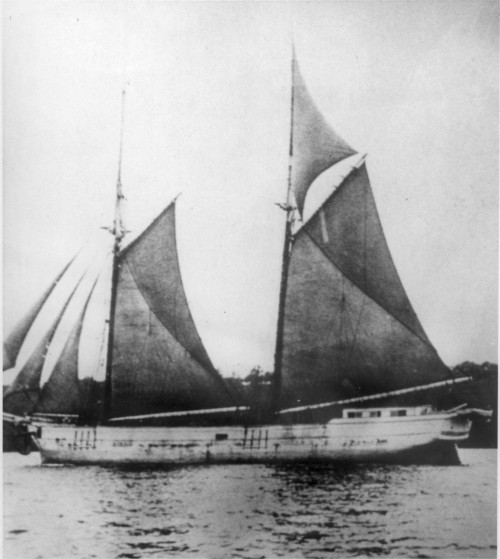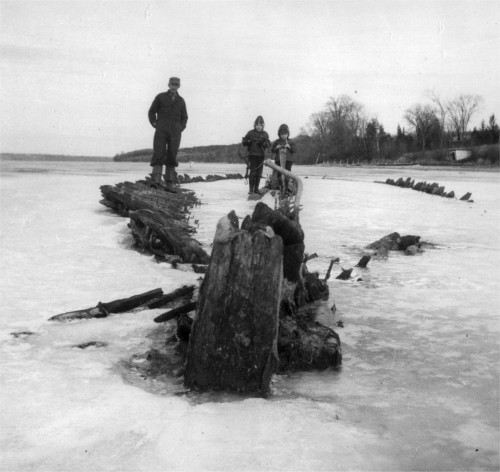My first trip across Lake Ontario
By T.W. Rose
Picton Gazette, 12 April 1934
Subject: an "imaginary", but most probably autobiographical, voyage of the OLIVIA in 1878. This 92 foot, 122 ton, schooner was built as the Emblem in Bronte in 1852, rebuilt and renamed Olivia after being run down by the Great Western steamer America in 1855, rebuilt again by John Tait at Mill Point (now Deseronto) in 1867, repaired and modified (remeasuring 144 tons) in 1873/74, and ended her days at Young's Cove, just outside Picton harbour 31 October 1879 where her timbers were visible until the 1960s. See our database entry for the schooner Olivia.
The author of these souvenirs, a teenager at the time, was sailing under the orders of his father Captain Alva Rose, then thirty-eight years old, who worked for the Olivia's owner Nelson Hudgin of South Bay. Mr. Rose himself became a sailor and a writer – he made many contributions to the Picton Times under the name of the “Doghouse Boy”.

I wonder if there are any readers of the Gazette who would like to take an imaginary trip, across Lake Ontario. If there are, I will take them back to an ideal, lovely, summer-like Sunday afternoon in early September, 1878, when I made my first trip across the lake. We will go down to the shore of South Bay where lay a tidy little schooner at anchor, the Olivia of Toronto. Below her decks was stored about 7,800 bushels of barley, destined for Oswego. The Olivia came to anchor there late on Saturday afternoon. The captain, realizing they could not get to Oswego on Saturday in time to get unloaded that day, decided to run up in South Bay, where all the crew lived near by, and they all could make a short visit at their homes and still go to Oswego in time to get unloaded on Monday. The crew was composed of Alva Rose, captain; Murney Ackerman, mate; Peter J. Ostrander, Phil Hudgin and N. Ackerman, boys of the dog house, no cook aboard that trip. They were all young men. The captain was 38 years of age; the rest of the crew were husky young fellows, barely out of their teens, and jolly good fellows they were. I soon concluded this was my chance to realize my long wished for dream, a trip across the lake in a sailing vessel. By appointment they all met on the shore on Sunday afternoon, where lay the yawl, a strong sturdy boat. Every vessel on the lake carried a yawl. The yawl was pushed into the water. A few minutes of brisk rowing brought us alongside the Schooner. The yawl was soon taken to the stern of the vessel and hooked on the davits, pulled up out of the water and securely lashed.

Then the anchor was hove short, and the task of hoisting the mainsail commenced, then the foresail and the staysail which was pulled over to one side, opposite to the way the schooner was to swing. Soon the anchor was up off the bottom and we were away on the course toward South Bay Point. The other two jibs and gafftopsails were soon set, and we were gliding merrily along through the smooth waters, passing familiar Potash Point so closely I could have thrown a stone on the beach. In the course of an hour or so we reached South Bay Point. Heading out through the passage between Gull Bar and the end of the point, we were soon on the broad expanse of Lake Ontario, which was this day in a quiet mood, as smooth as the proverbial pane of glass. The wind was moderate and about south-west, and we were gliding smoothly along with a start of sheet.
Glancing around over the broad expanse of the lake, only one sail was in sight, a few miles ahead of us. On the course toward Oswego was the new white sails of the schooner, Wm. Jamieson a new boat which was built at Mill Point (now Deseronto), and had come out that season. The schooner was designed by Wm. Jamieson and named after him. Sundown came and soon darkness set in, the watches were named and one watch went below for their four hours’ sleep. I, farmer-style, turned in for an all night sleep.
Early in the morning I was awake and soon out on deck and looking out over the bow, failed to see any boat ahead of us. I expected to see the Jamieson in that direction.
We were still sailing along with a start of sheet, asking the man on watch about our companion of the night before. “There she is,” pointing over the stern, a few miles astern. We had passed her in the darkness. Events proved that the Olivia was the faster boat with a start of sheet, but_the Jamieson was the faster one by the wind, which was soon proved out. As we got nearer to the south shore the wind came off the land. The sails were pulled flat in the endeavor to lay the course to Oswego. We were then well in sight of the land but the shoreline all looked the same to me, but those experienced men pointed out to me the exact point where Oswego lay. Now that we were sailing close to the wind, I saw that the Jamieson was slowly and surely gaining on the Olivia and ere long was in the windward position.
Presently we could see a cloud of smoke and then the word that the tug was coming out. I could see the apparently small tug as it came leisurely along over the ground swell. Of course the Jamieson being to weather, the tug took her in first, then coming right out again for us, soon had us placed nicely along one of the several elevators on the east side of the harbor. The tug which towed us in that day was the C. P. Morey. This, and the Fred Wheeler, were the Oswego tugs at that time. Later they were succeeded by the tugs M. J. Cummings, the Eliza J. Redford, the John Navagh and the Charley Ferris. All of these tugs have gone years ago. After a little time preparations were made for unloading the barley.
Unloading the Cargo
The elevator leg was placed in the after hatch. The deck was lively with the sons of Erin, each equipped with a wooden shovel. Their job was to shovel the grain up to the leg as it was carried up in the elevator. Experts they were at that job, like clockwork did they handle those shovels. After a couple of hours the job was completed, the hold was swept clean of grain, and the vessel tidied up for the return trip. After this job was done I took a stroll up town. I wanted to buy a suit of those noted Oswego clothes. We went to a store which was liberally patronized by the sailors of that day. It was familiarly known as “Old Rips.” He was a merchant of Palestine, not a merchant of Venice. He soon convinced me that he could sell me a nice suit of clothes for a little bit of money, and soon I was the proud owner of a suit of clothes. Of course they were to be my best suit of clothes. After wearing them not a great deal I found that at the knees, also at the elbows, they began to separate. It was really a two-ply suit. I never let that merchant know anything about it, as I had only paid him for one suit and thought he might want me to pay him for two suits.

Toward sundown the tug came alongside to tow us out into the lake on the return trip. The wind was still offshore. After getting all the sails set we were sailing along nicely with long sheets and heading for the False Ducks light. Again the watches were set, and again I turned in for an all night sleep. Early in the morning I was awake. On going on deck I found we were at anchor, not far from Mill Point, and at the mouth of the Napanee river, sails all furled and everything quiet. A nice breeze was blowing still from the south. I didn’t know what time we arrived there, but concluded they had made a pretty quick run from Oswego to Mill Point. The captain had chartered for another load and was to load part at Napanee and finish at Mill Haven, and now was waiting for the little steamer Flight (which made daily trips between Prinyer’s Cove and Napanee) to tow us though that winding, shallow river to Napanee.
In due time the Flight came in sight, and then a hurry to get the anchor up and we were off once more. Near noon we arrived in the snug little harbor at Napanee. The rest of the day was spent looking around that thriving little town. Wednesday morning came all too quickly was to start that day for home on the return trip of the Flight. I was due to get off at Picton, I got a chance out to South Bay with an old friend. Before leaving the Olivia for home the captain dealt liberally with me for helping a little around the galley, washing dishes, etc., by arranging for my fare to Picton, also giving me one dollar and twenty-five cents - to me a large sum of money in those days of hard times. I arrived home about dark on Wednesday evening, having been gone from home three days. And what a three days it was to me. The experience is still prized by me after all those intervening fifty-five years. A pleasant memory of those old “Schooner Days.”
